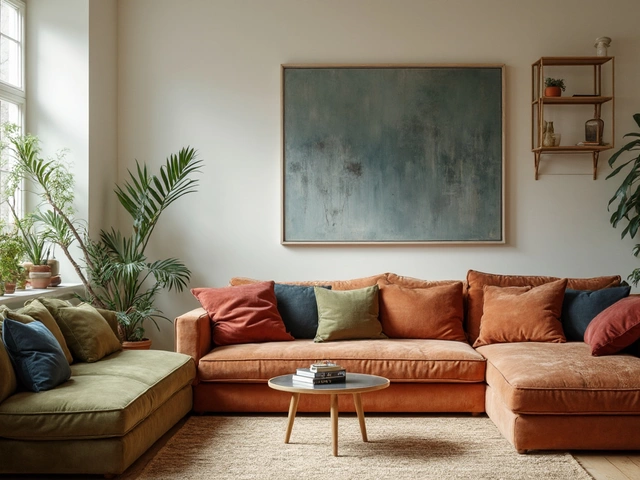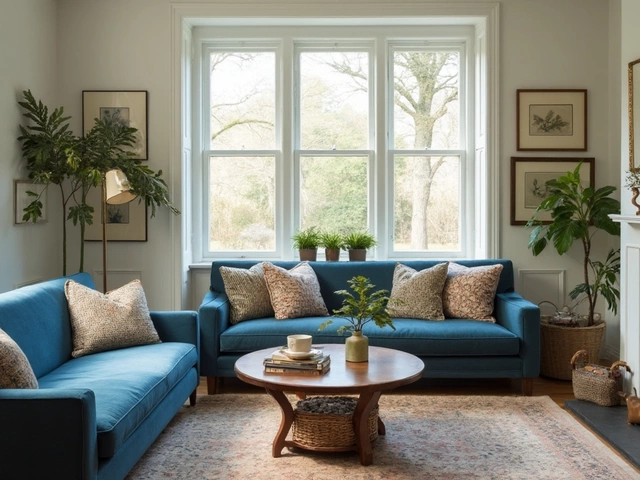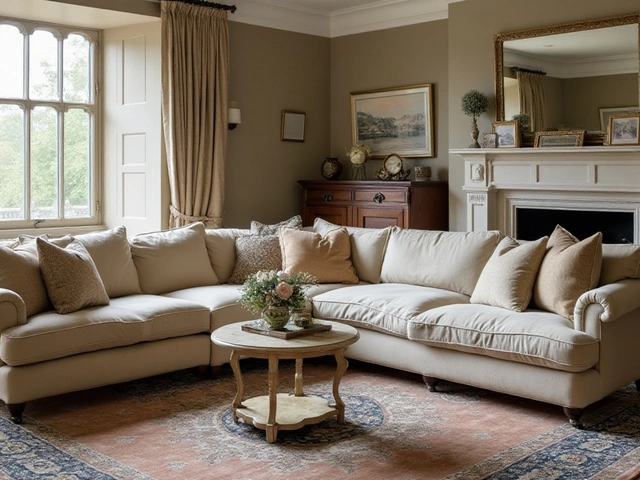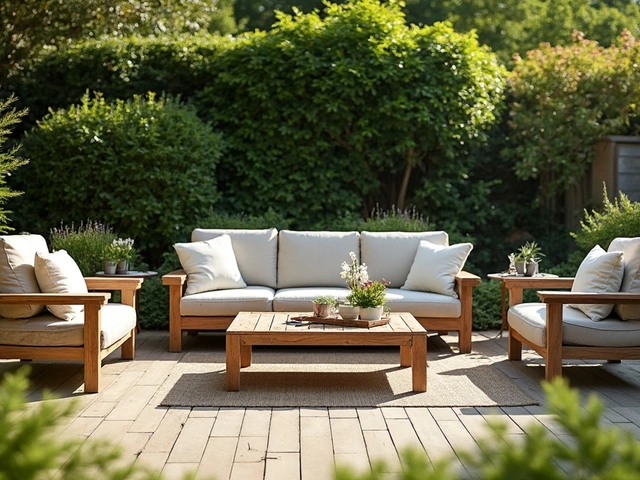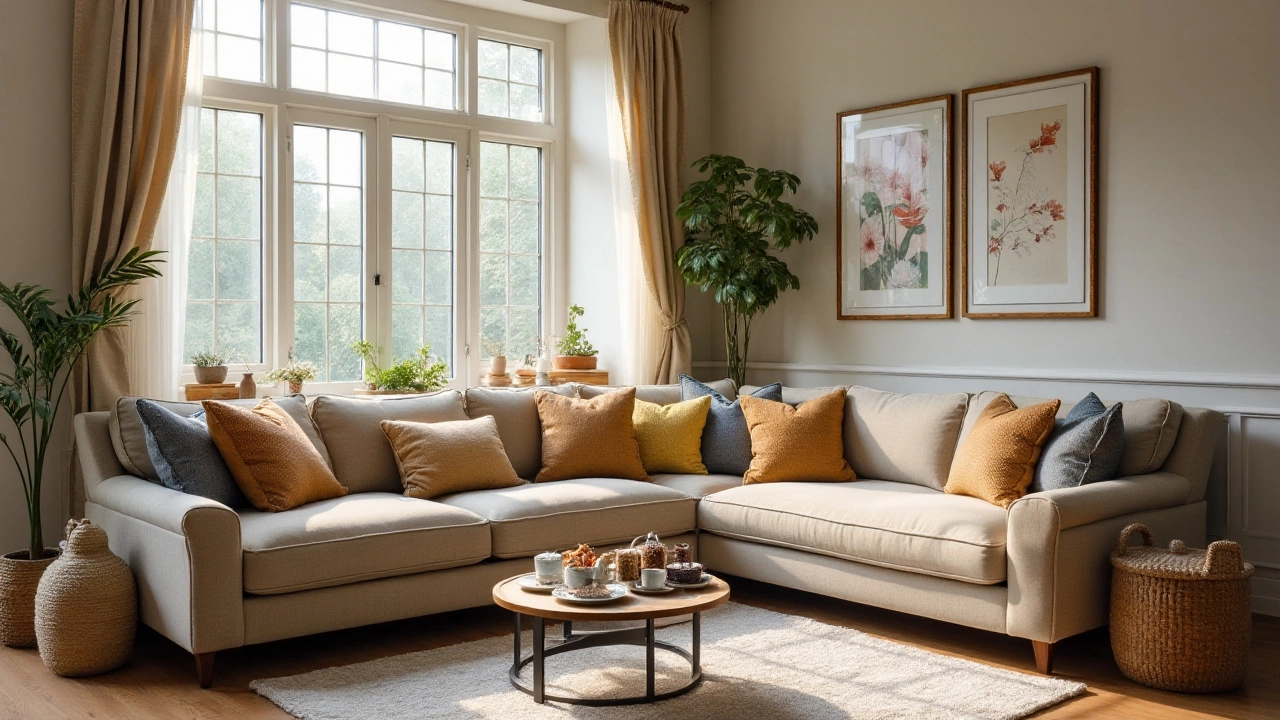 31
Dec,2024
31
Dec,2024
In the realm of interior design, the 3-5-7 rule serves as a guiding principle that can redefine your approach to arranging furniture, particularly with larger pieces like corner sofas. The rule emphasizes grouping items in odd numbers as a way to create visual interest and balance. But what makes this approach so effective, and how can it be applied to maximize the style and comfort of your living space?
Implementing the 3-5-7 rule with your corner sofa involves understanding the magic of uneven numbers and how they contribute to aesthetic appeal. This technique is not just about filling space but about crafting a cohesive and inviting atmosphere. Dive into the essence of this rule, explore how to select the right corner sofa, and discover ways to harmonize it with other room elements for a polished, harmonious look.
- Understanding the 3-5-7 Rule
- Benefits of the Rule in Living Room Design
- Choosing the Right Corner Sofa
- Harmonizing with Room Elements
- Creative Placement Tips
- Personalizing Your Space
Understanding the 3-5-7 Rule
The 3-5-7 rule in interior design is much more than just an aesthetic guideline; it's a foundational principle that taps into the human psychology of perception. Odd numbers have a unique appeal and create a sense of natural balance, which is why designers use them to enhance the visual impact of a space. This rule suggests that grouping decorative elements or furniture pieces in sets of three, five, or seven can create a more engaging and dynamic display. Whether you're arranging picture frames or positioning a corner sofa, odd numbers add an element of surprise that keeps the eye moving, making spaces feel more alive and interesting.
The science behind this approach can be traced back to how our brains interpret groups of items. Unlike even-numbered arrangements, odd numbers don't provide perfect symmetry, which often leads to more curiosity and engagement. This makes them ideal for adding depth to room layouts without overwhelming the senses. When applied to the usage of a corner sofa, the 3-5-7 rule helps anchor the piece within its surroundings, giving it prominence while still allowing the other parts of the room to flow around it naturally. As Leatrice Eiseman, a renowned color specialist, once mentioned, "The eye needs a sense of movement—a little surprise never hurts."
This principle exploits our innate preference for asymmetry, fostering creativity and uniqueness in home decor.
Using the 3-5-7 rule isn't confined to just furniture arrangement; it extends to decor accessories as well. Imagine a living room where two cushions sit symmetrically on either side of a corner sofa. Adding a middle cushion disturbs the symmetry, creating an unexpected focal point that draws in viewers. Similarly, placing decorative items like vases or figurines in odd numbers on a coffee table compliments your seating arrangement and infuses a sense of completeness.
To effectively incorporate the rule, it's important to be mindful of scale and proportion. A small object in an odd-numbered trio could get lost if its surrounding pieces are too overpowering. Balance, here, doesn't equate to equality in size, but in the visual weight an object holds. Consider using a mix of sizes, textures, and colors to add depth and variety to the ensemble. For spaces featuring a large corner sofa, experimenting with different element groupings like small tables or standing lamps can maintain harmony while following this design principle.
The beauty of the 3-5-7 rule lies in its flexibility—it doesn’t set hard and fast lines but allows for creative expression within a structured framework. Trying to enhance your home decor can sometimes feel overwhelming, but harnessing this simple guideline enables you to bring character to your living room effortlessly. Large pieces like a corner sofa become a more integral part of the environment rather than a separate entity, minimizing visual chaos and establishing a welcoming and organized area.
Finally, these odd-number arrangements also work wonders in creating contrasts within your design palette. You can highlight a sophisticated piece of furniture or artwork by juxtaposing it against a series of smaller items arranged using this principle. As it pivots on personal creativity, there's room to let your instinct guide your eye, while the rule provides the reassuring foundation of time-tested good taste. By marrying the 3-5-7 concept with your personal style, your home not only becomes aesthetically pleasing but almost sculptural, with dynamics that keep guests intrigued and entertained.
Benefits of the Rule in Living Room Design
The 3-5-7 rule in interior design, especially when applied to living room arrangements, serves as a fundamental principle that architects and designers alike have come to rely on for creating captivating and balanced living spaces. When it comes to placing corner sofas, this rule transforms the living room from a simple lounging area into an arena of visual delight and comfort. The concept of odd-numbered groupings is thought to be intriguing to the eye because it encourages one to visually move things around. This natural rhythm keeps the space from appearing too static or rigid, helping to break the monotony that commonly results from even-numbered arrangements.
Corner sofas, by their nature, are significant investments in both space and money. They dictate the flow and dynamic of the room, making it essential to place them thoughtfully. By applying the 3-5-7 rule, one can accentuate the angles and elegance of a corner sofa with added layers of interest. Imagine a 3-item arrangement around a sofa: a stylish lamp, a plant, and a bean bag perhaps. These uneven combinations draw focus and create a cohesive yet dynamic space that's both practical and aesthetically pleasing. Such principles not only assist in maintaining harmony within large, open spaces but can also be adapted to smaller settings.
From a psychological standpoint, odd numbers are more enticing and feel less forced. They offer a whimsical way of approaching design that can result in unexpected, delightful visuals. It’s worth noting that the 3-5-7 rule is not limited to the living room alone; its guiding principles can be so versatile, they easily cascade into entire home settings. Designer Sheila Bridges once observed, "Design is not just what it looks like and feels like. Design is how it works." This quote resonates well when you consider how the 3-5-7 rule helps in creating spaces that not only look great but function beautifully. Each element, whether it's a sofa, a lamp, or a vase, has its place and purpose, contributing to an overall sense of order and style.
In practice, employing the 3-5-7 rule in your living room can open up a plethora of decor styles. Combine it with other elements like texture and color to further enhance the ambiance. For instance, alternating between different textures—such as soft throws draped casually over a corner sofa or the introduction of metallic accents through lamps and artwork—creates richness and depth. Color, too, plays a crucial role in this discipline. By using a palette that both contrasts and complements your primary sofa shade, you end up with a vibrancy that immediately attracts attention. A brilliant solution is a complementary pattern or pop of color that adheres to the theme without overtaking it, a concept conveniently balanced by the rule we discuss.
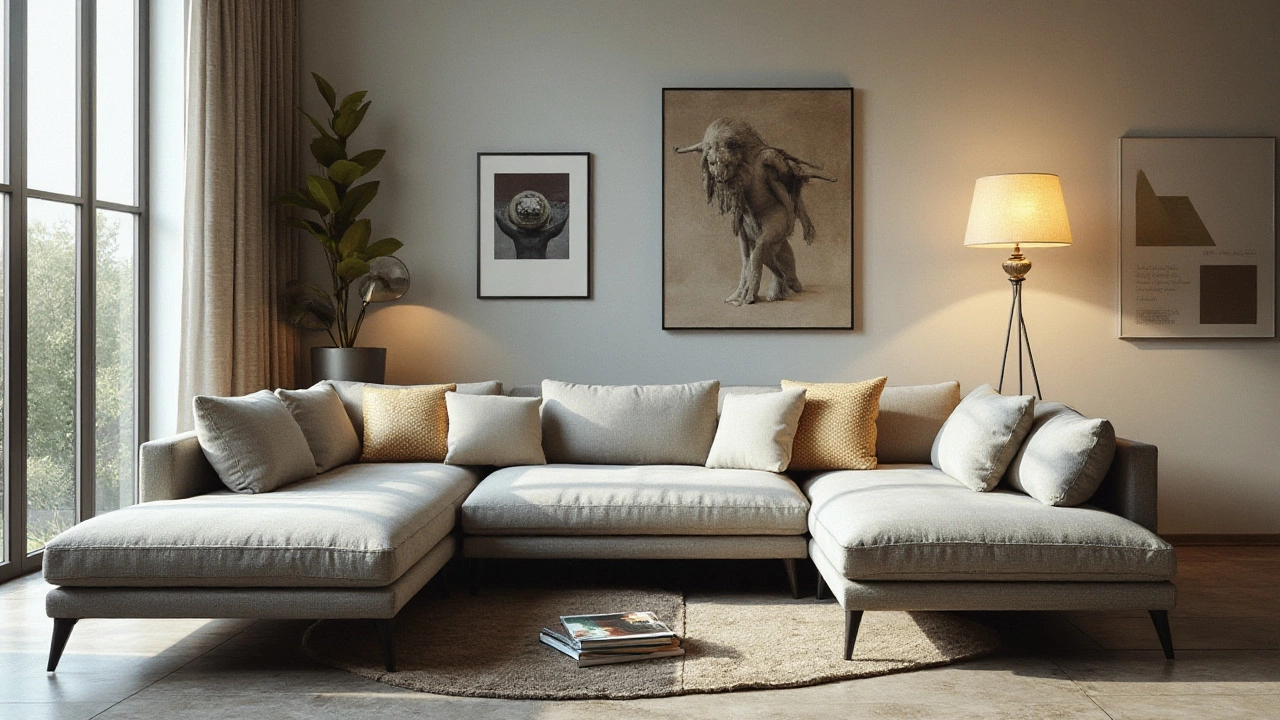
Choosing the Right Corner Sofa
When it comes to selecting the perfect corner sofa for your living room, understanding the nuances of your space and lifestyle is crucial. A corner sofa can be a significant addition, both in terms of size and style, acting as the heart of your living area. Before making a decision, start by assessing the layout and dimensions of the room. Measure carefully to ensure that the sofa not only fits but enhances the space without overwhelming it. Consider the traffic flow and how the sofa will interact with existing architectural elements and furniture pieces. This strategic placement will ensure a balanced and functional environment.
Material choice plays a pivotal role when you're choosing a corner sofa. If you have pets like a cat, such as my own inquisitive Tigger, or young children, prioritize durable and easy-to-clean fabrics. Leather and microfiber offer resilience and ease of maintenance, while also providing a touch of elegance. Additionally, think about color and pattern. Neutral shades often work best as they integrate seamlessly with various design themes and other home decor items. However, a bold color or pattern can serve as an eye-catching focal point, embodying your personal style. Reflect on your lifestyle needs and the statement you wish to create.
Comfort is another cornerstone (pun intended) of a corner sofa's appeal. Before committing, test the sofa's firmness and cushioning. A well-chosen sofa should provide adequate support while still offering a plush retreat after a long day. Remember, the backrest and armrests should also cater to your comfort preferences, whether you prefer lounging with a book or hosting movie nights. As design expert Sheila Bridges mentions, "A truly great piece of furniture is one that marries form and function, offering comfort without sacrificing style."
If the sofa is your solace spot, prioritize a style that invites warmth and relaxation.Tailor your selection to ensure you and your family can truly unwind in your own space.
Don't overlook the framework and craftsmanship of the sofa. A robust frame made from hardwood like oak or teak can guarantee longevity, especially compared to softer woods. While assessing the build, lift one corner of the sofa to test its sturdiness - a well-constructed piece should not flex or creak. For a long-lasting piece, joints should be kiln-dried and glued, reinforcing the sofa's durability. Attention to these details not only enhances your sofa's lifespan but also its aesthetic appeal. With quality in mind, your corner sofa can be a treasured companion for years.
The flexibility of a corner sofa is another advantage worth considering. Many modern designs offer modular options. This adaptability means you can reposition sections to suit different occasions or room layouts, providing both flexibility and creativity in your design. Whether you're hosting a large gathering or enjoying a quiet evening reading, your corner sofa can reconfigure to meet your changing needs. Explore options like detachable ottomans or couches that can transform, allowing for a personalized arrangement anytime inspiration strikes. Such versatility becomes invaluable, especially in homes where spaces serve multiple purposes.
Lastly, keep an eye on the latest trends in interior design. While a classic corner sofa design remains timeless, elements like sustainable materials and ergonomic features are increasingly popular. Staying informed on these trends not only ensures your sofa is stylish but also aligns with eco-friendly living practices. Additionally, understanding the evolving design landscapes can inspire you to blend traditional comforts with contemporary flair, creating a unique space reflecting both your taste and responsible lifestyle choices. As you embark on the journey to find the right corner sofa, remember that the ideal choice is one that complements both your home and your lifestyle.
Harmonizing with Room Elements
When stepping into the world of interior design, especially while working with corner sofas, the idea of making your furniture mesh well with existing room elements might seem daunting. The way you arrange your living room can transform not only the aesthetics but also the comfort and functionality of the space. The 3-5-7 rule is an ideal tool to address this, ensuring that your living space feels balanced, visually pleasing, and 'lived in'. The context of the rule in identifying odd numbers isn't just about remission in design chaos but encourages creativity that order alone can't achieve. Consider working with lighting first; a combination of overhead lights, floor lamps, and perhaps some ambient fairy lights can create layers in brightness that offer both practicality and enchantment. Equating light with proportions can dramatically change room dynamics.
Another essential aspect is color coordination. The color palette of your room, including the corner sofa, should unify rather than divide. Typically, three colors work best based on the rule: a dominant shade for the walls and large pieces, a secondary color for mid-level pieces like side tables or artwork, and a third color for accents in your cushions or accessories. Bold color choices often reign in modern designs, yet the 3-5-7 rule encourages using such tones sparingly and selectively. According to famed designer Emily Henderson, "Incorporating color with this method allows the simplest room to turn vibrant without feeling overpowering." Embrace the natural hues from the structure of the room, like wood tones and any visible brick, to complete a look of effortless style.
Your flooring can equally contribute to or detract from the cohesion in your living space. Choose rugs or carpets that grab attention yet complement the larger interior design scheme. For instance, if your sofa and walls are in warm hues, a cooler-toned rug or vice versa can anchor the room. When it comes to furniture positioning, consider spatial clearance for efficient walking paths. Your corner sofa should not only accommodate its primary role as a seating area but also provide a sightline to other areas, promoting traffic flow and engagement across the room. An inclusive environment encouraged by the rule is beneficial not only for household members but for visitors, making every gather a social delight.
Let's not forget about the smaller elements, as they equally wield power in achieving visual harmony. Vases, artworks, and even books are perfect elements to display in odd numbers, exploiting the erudition behind the rule. A cluster of three vases, each at varying heights and perhaps slightly different in texture or color, can provide a dynamic display while not overwhelming the senses. This principle can also be applied to wall art arrangements—use a series of five or seven frames to create a visual narrative that draws the eyes naturally to the sofa and beyond. Remember that simplicity often commands elegance, leading to a clutter-free appearance.
| Room Element | Harmonizing Tips |
|---|---|
| Lighting | Layer with multiple sources, adjusting based on need. |
| Color | Use three-toned palettes for a unified look. |
| Rug/Flooring | Opt for contrasting rugs to anchor warmth or cool shades. |
| Artwork | Arrange in odd numbers for a balanced display. |
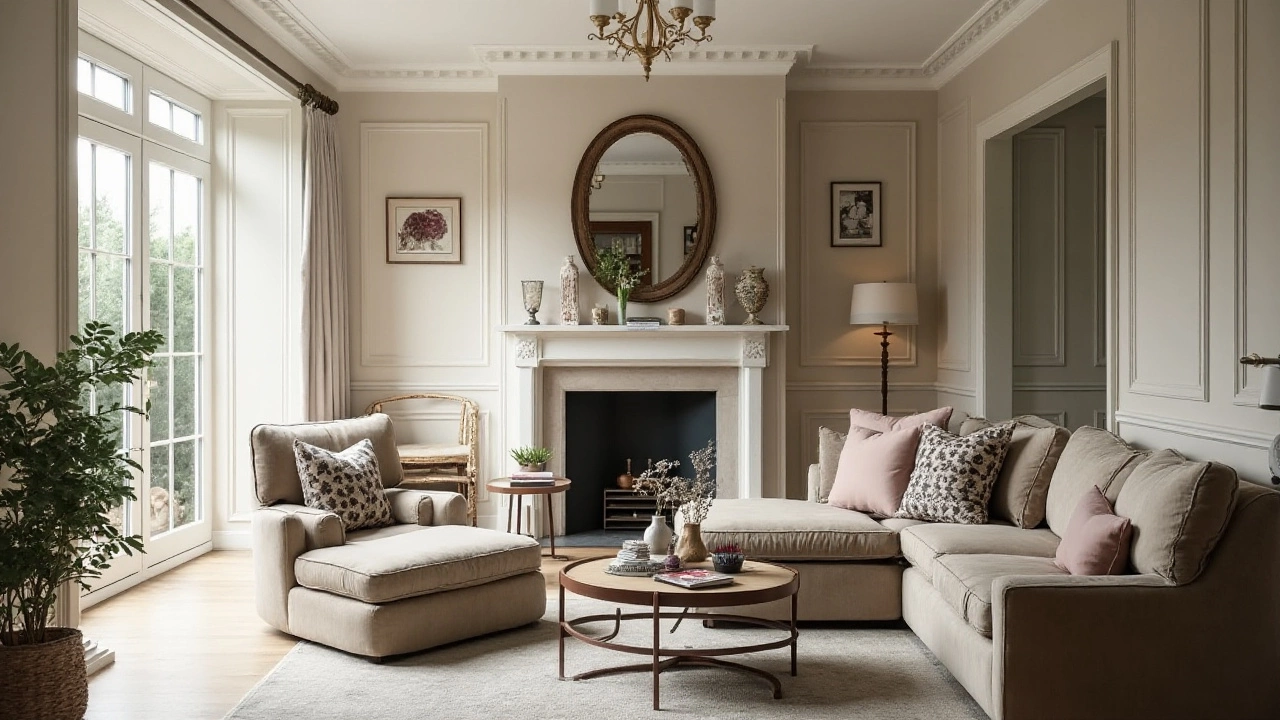
Creative Placement Tips
Arranging a corner sofa is more than just finding a spot and pushing it against a wall. It's an opportunity to create a room that feels inviting, balanced, and full of personality. One of the most important things when placing these voluminous furniture pieces is to consider the flow and function of your space. Start by determining the room's focal point. This could be a fireplace, a large window, or even an entertainment center. Aligning the sofa with the focal point creates a natural eye-line and ensures that the seating feels purposeful in the space.
Next, consider the views both into and out of the room. If possible, position the corner sofa to maximize natural light, which can make the room feel brighter and more open. This is especially important if your living area connects to an outdoor space, as it can visually extend the indoor environment into the outside world. According to Miriam Fanning, a renowned interior designer, "The alignment of the sofa with natural light not only enhances the aesthetic quality of the room but also promotes a sense of well-being."
When placing a corner sofa, it's crucial to ensure that there is plenty of room to move around comfortably. This often means leaving at least 36 inches of space between the sofa and other furnishings to facilitate easy passage. This can be achieved by experimenting with different angles, instead of always sticking with perpendicular walls. Angled placements can break up the monotony and inject a bit of dynamic energy into the setting.
Color and texture play essential roles in how your corner sofa integrates with the rest of the room. Consider incorporating throw pillows or rugs that complement the color of the sofa, creating visual continuity in the room. This doesn’t mean everything should be perfectly matched, but rather that some colors or patterns can be repeated to tie the room together. Use contrasting textures to add depth and interest. For instance, a leather sofa pairs beautifully with a soft wool throw, providing a balance of sleek and cozy.
In smaller spaces, corner sofas can be a blessing, making use of often-unused angles of the room. But it’s important to measure your space accurately before purchase. You don’t want to end up with a piece that overwhelms the room or impedes other functional areas. Portable side tables and plants can be used as additional decor elements that can shift focus and add variety to the layout of the room.
Lastly, don't shy away from accessorizing the living space surrounding your corner sofa. Artworks, mirrors, and lighting play pivotal roles in completing the aesthetic of a room. An intriguing piece of art can serve as a conversation starter when placed right above the sofa, creating height and drawing the eye upward. Meanwhile, strategic lighting, whether floor lamps or overhead fixtures with dimmer capabilities, can help set the mood according to different times of day or occasions.
Personalizing Your Space
Giving your living space a personal touch goes beyond mere aesthetics. It's about creating an environment that reflects your personality and lifestyle. The corner sofa you choose is not just a piece of furniture; it's a cornerstone of your home's design language. By applying the 3-5-7 rule, you can enhance the visual appeal and functionality of your living area. This is where creativity meets practical solutions, allowing you to transform the ambiance without compromising comfort.
When personalizing your place, the first step is to understand your color palette. Colors significantly impact the mood of a room, influencing energy levels and even emotions. If you’re seeking a calming environment, soft, neutral tones might be preferable. On the other hand, vibrant hues can energize a space, making it lively and inviting. Pairing your corner sofa with scatter cushions or throws in varying textures and colors creates a cozy yet stylish look. As famed designer Nate Berkus once said,
“Your home should tell the story of who you are, and be a collection of what you love.”
Lighting also plays a pivotal role. The strategic placement of lamps or ambient lights can dramatically change how your corner sofa sits in the room. Using layered lighting techniques, such as combining floor lamps with wall sconces, can add depth and warmth to your space. Additionally, the choice of a rug should not be overlooked. Rugs can anchor a space, especially in open-plan living areas, while adding texture and pattern. The size of the rug should complement the scale of the sofa and the room dimensions to maintain balance, in keeping with the rule principle of odd-number groupings.
Adding personal items, such as family photos, art pieces, or memorabilia, offers a personal signature to the living room. These elements should be displayed thoughtfully; for instance, a three-piece artwork above the sofa could adhere to the 3-5-7 arrangement, creating a focal point that draws the eye. This idiosyncratic touch not only injects individuality but also sparks conversation, offering guests a glimpse into your world through your decor choices. An interesting statistic from the Home Trend Report suggests that personalized spaces contribute to a 25% increase in homeowner satisfaction. This stands testament to how meaningful customization can significantly enhance your home experience.
The integration of corner sofas with other decor should reflect both function and style. Some opt for multifunctional pieces that offer storage, while others choose designs that prioritize comfort. The key is to find a balance that works for your lifestyle without sacrificing style. In large spaces, sectional sofas might be the best fit, providing ample seating and defining the room's perimeter. For smaller spaces, a corner sofa with slim arms and a compact silhouette might be more suitable, reinventing how space is utilized without feeling cramped.
Personalizing your space with the 3-5-7 rule involves engaging all senses to create an inviting and harmonious atmosphere. It's an art that marries personal taste with the science of design, delivering a space that is uniquely yours. Whether you're curating an intimate nook for quiet evenings or crafting a lively living area for social gatherings, the corner sofa remains a pivotal element, dictating form and function across your enchanted sanctuary.
